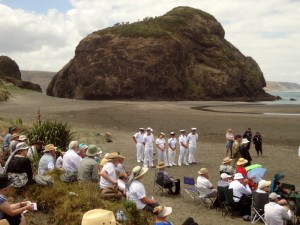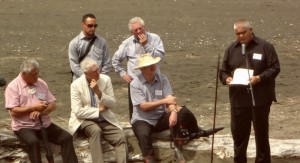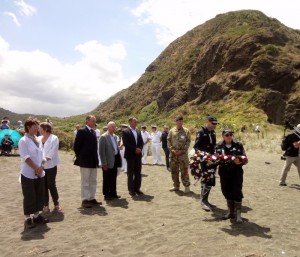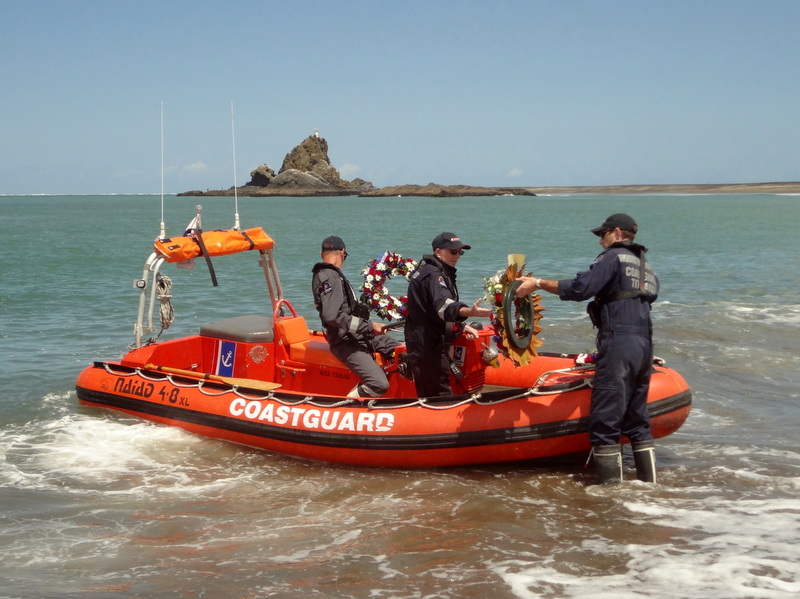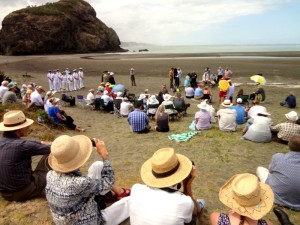 On this hot sunny Thursday, 9 February, a large group gathered at Whatipu beach: young and old, Maori and Pakeha, navy personnel in uniform, a priest and uniformed Coastguard. They were all there to commemorate the 150th anniversary of New Zealand’s worst maritime disaster.
On this hot sunny Thursday, 9 February, a large group gathered at Whatipu beach: young and old, Maori and Pakeha, navy personnel in uniform, a priest and uniformed Coastguard. They were all there to commemorate the 150th anniversary of New Zealand’s worst maritime disaster.
On the 7th February 1863, the British steam corvette HMS Orpheus foundered on the Manukau Bar with the loss of 189 officers and men. Instead of following Harbourmaster Wing’s instructions, the vessel was following an out-of-date Admiralty chart. Captain Burnett had never visited the Manukau before – in fact, the only person on board who knew the course was wrong was a rating called Butler who was in the lock-up for desertion. He was screaming to be taken out, but by the time he was able to warn Burnett he had taken the wrong course it was too late for the doomed ship.
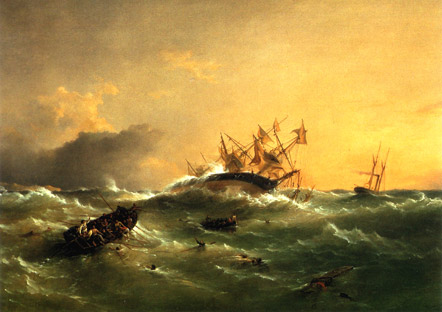 Though the Orpheus was a steamship, it still had masts and sails, and though Burnett told the men they could take the lifeboats and take their chances with the waves, most took to the rigging. From there they could be heard singing and cheering by the rescue ship the Wongawonga which was unable to get very close. In the blackness of the night, the sailors on the Wongawonga heard three cheers go up, before one of the Orpheus‘s huge masts went crashing into the sea taking the sailors with it.
Though the Orpheus was a steamship, it still had masts and sails, and though Burnett told the men they could take the lifeboats and take their chances with the waves, most took to the rigging. From there they could be heard singing and cheering by the rescue ship the Wongawonga which was unable to get very close. In the blackness of the night, the sailors on the Wongawonga heard three cheers go up, before one of the Orpheus‘s huge masts went crashing into the sea taking the sailors with it.
A party of Maori in a row boat rescued some men and pulled in bodies which they buried on the shore. Other bodies washed up all along the coast, including Piha and Muriwai.
Some of the men took the opportunity to abscond and “went bush” so the actual number of survivors – thought to be 70-80 – cannot be certain.
This history was outlined at the ceremony by Michael Wynd, a naval historian. He was followed by Te Warena Taua for Te Kawerau a Maki, Sir Bob Harvey and Wayne Mackenzie.
Te Warena talked about his mixed feelings about the history, his attendance being out of respect for the men who died. The Orpheus was a war ship, brought to New Zealand during the Waikato War: “It was a boat carrying guns to invade our land.”
The Maori interpretation of the event is that the day before, a settler had felled a sacred puriri on Puketutu Island and so the harbour’s resident taniwha “tossed that boat”. He outlined his iwi’s experience of the war, which resulted in its retreat into the Waikato and the confiscation of its land. “When we came back to Ihumatao, we had nowhere to go. The land was sold by people who had no right to sell it, or it was confiscated.”
Wreaths were brought by Jenny Newman, representing descendants of the crew, and Barbara Harvey as a descendant of Captain Wing, also by the museum. These were taken by the Harbourmaster and Coastguard out to lay on the water at the Bar. As the gathered people sang “Abide with Me”, a voice was heard eerily coming over the water “Coastguard, lay your wreaths”.
This moving ceremony was followed by a lunch, and then people repaired to the Huia Hall where a number of people presented papers on aspects of the Orpheus. Congratulations to Bruce and Trixie Harvey and Friends of Whatipu and others who organised this event, and thanks to Harbourmaster, Coastguard, Navy and park rangers who all performed various tasks. There were also church services in other parts of Auckland.



